Is the Platinum Rolex Perpetual 1908 with a Guilloché Dial Really That Good?
The dress watch no one was expecting from Rolex, and one of the best surprises of the show...

When it was unveiled last year, the Rolex Perpetual 1908 made quite a strong impression. I know that the brand doesn’t want to call it the successor to the Cellini line but the reality is that it is an Mk2 Cellini. The inaugural models were surprisingly appealing despite their minimalist, almost empty dials. Rolex isn’t really associated with the dress watch category – the dressiest reference would otherwise be a Day-Date. Still, with 1908, the brand has made a resounding entrance in the game, proving as refined and sophisticated as some of the usual suspects (VC, PP et al.). This year, the brand added a touch of traditional craftsmanship, an area of the industry where the brand is not necessarily overly present (spoiler: they are, more than one would think) by introducing this beauty: the Rolex Perpetual 1908 in platinum with a truly stunning ice-blue guilloché dial. Time for us to give our verdict.
A reference to the year founder Hans Wilsdorf created the brand name Rolex, the very name of the Rolex Perpetual 1908 immediately communicated its intentions. It is a watch that pays tribute to the brand’s origins, to its past, to traditional watchmaking. It is, without a doubt, the brand’s vision of a classic dress watch, using most of the codes of the genre. Even though Rolex doesn’t really want to talk about it, the new Perpetual 1908 collection was designed to replace the Cellini range (discontinued entirely in early 2023) with a sleeker look but, on the other hand, quite a lot to talk about regarding its technical execution. There was even an open caseback (in the world of Rolex, considered a revolution). The initial collection comprised four models, in white or yellow gold, with matte black or white dials. Discreet editions that were perfect to set the basis of the collection.
Now, the brand gives it a twist with a piece that’s more luxurious, more striking visually, subtly coloured and with a dial that has much more to tell… And it’s been done in a rather unexpected manner, with a guilloché dial.
The ice-blue rice-grain engine-turned dial
Let’s talk about the important element in this context: the dial and its execution. First of all, we tend to overlook Rolex as a dial maker. Sure, the dials of many watches – specifically within the professional range – are relatively simple, being lacquered with applied markers in precious metals. Don’t get me wrong, Rolex does great dials and the level of precision and refinement is there. It’s just that there’s nothing exceptional in this context. However, Rolex has genuine expertise in dial-making and has worked for decades in the field of rare materials (MoP, meteorites, natural stones) and gem-setting. And remember last year, the puzzling Day-Date 36 with a jigsaw dial? Well, that was made using a champlevé enamelling technique.
This year, with its Rolex Perpetual 1908 Platinum, the brand introduces yet another traditional decorative craft to the equation, engine-turning. As we explained in this Technical Perspective article, there are multiple ways to create a so-called guilloché dial – traditionally on a rose engine or a straight-line machine controlled by the hand of a skilled engraver, in a slightly more industrial way on a replicating machine with a mechanical lathe, and then in fully-industrialized ways via CNC machining or stamping.
What about the ice-blue dial of the Rolex Perpetual 1908 Platinum? Well, as often with the brand, Rolex remains pretty discreet about the processes, but we’ve been told that it was done “the traditional way” using traditional guilloché engine-turning equipment and techniques. While I certainly don’t see a brand of the scale of Rolex manufacturing dials in the way specialized artisans do, the dial of this 1908 is done on hand-operated machines employing traditional methods. A closer inspection reveals a texture that has the traits of classic guilloché with visible marks of a cutting tool.
This striking, unexpected yet highly appealing dial comprises two distinct textures: a rice-grain motif covering most of the dial, with its rosette-like design and repeated pattern radiating from the centre of the small seconds counter and a double filet sauté with a crimped pattern framing the minutes track on the periphery of the dial. Some “industrial” techniques are, however, visible still in some areas. For instance, the recesses surrounding the logo, chronometer mention and small seconds are undoubtedly the result of a milling technique and not a traditional guilloché process.
in real life, the pattern appears far more delicate and appealing than in the brand’s official images. A close inspection reveals almost no visible flaws, while it is common for artisan-made, hand-guilloché dials to sport flaws (specifically on the borders of the textures), making some think that the 1908’s dial was the result of CNC machining – which it isn’t. The result is refined, precisely executed and particularly appealing, making for a watch that doesn’t necessarily look Rolex but feels Rolex when looking at the technical side of things. When the crown does something, it usually does it right.
What’s clearly Rolex is the colour. The ice-blue tone chosen for this watch is not just a pretty colour; it is completely in line with other sought-after platinum watches from the brand, such as the Daytona reference 126506 or the Day-Date 40 reference 228236. What makes this 1908 different is the addition of a texture to this colour, resulting in a dial with more depth and more playfulness, as well as bringing the feeling of being a modern take on the traditional guilloché technique. The dial is, however, quite shiny, and the small seconds would have felt more “integrated” if it had its own much thinner texture too.
For the rest, we have the same design elements as last year’s versions, with a printed railroad minutes track, applied white gold markers combining faceted batons and numerals at 3, 9 and 12, and faceted polished white gold hands with a distinctive hour hand, connecting this watch to the rest of the collection – which could do, in my opinion, with a slightly different design.
An elegant dress watch with Rolex hallmarks
For the rest, this Rolex Perpetual 1908 Platinum reference 52506 remains in line with the inaugural models of last year. We have an elegant, restrained case of 39mm in diameter, 9.50mm in thickness and about 47mm in length. What sets it apart is the use of 950 platinum, which doesn’t make it look much different from a white gold version but does give it a reassuring, high-quality heft on the wrist – platinum is about 25% denser than 18k gold. It is, without a doubt, a modern vision of a dress watch that plays on the larger side of the category, but the slim, pointy lugs and the use of a fine fluted pattern on the bezel add a touch of retro refinement that tones down its contemporary proportions – and, as a side note, the fluted pattern of the bezel echoes the dial’s filet sauté pattern, which in my eyes looks particularly appealing and consistent.
The Perpetual 1908, and particularly this new platinum version, is a watch of great elegance despite having a slightly frenetic use of textures. It all blends well when viewed from a certain distance – understand the standard eye-wrist distance. What you see here in the photos amplifies the patterns. It’s far more subtle and discreet in real life, even though this version appears more striking and polarizing than its gold counterparts. Like the dial, the case is superbly executed, with great attention to the finishing and assembly – nothing to be surprised at here; it’s a Rolex, after all.
Under the sapphire crystal back is the same calibre 7140 used inside the gold editions. Developed specifically for this collection, this automatic movement combines modernity and classism. Classic in its architecture, with a central rotor, a thin profile, and a visible ratchet wheel and barrel, it does, however, use the brand’s latest technologies. It is wound by a solid 18k rotor mounted on a ball bearing, and it incorporates the patented Chronergy escapement made of anti-magnetic nickel-phosphorus as well as a much rarer technical solution, the Syloxi hairspring, produced by Rolex from silicon with a patented geometry (and not the blue Parachrom hairspring found on most other watches). The regulating organ, with a variable inertia balance wheel regulated via two gold Microstella nuts, is held in place under a traversing balance bridge. The power reserve is comfortable, rated at 66 hours.
Having a sapphire back, Rolex made an effort regarding the decoration of the calibre 7140, giving it a more traditional and warmer appeal than that found on a calibre 32xx. It includes Rolex Côtes de Genève – a decoration that differs from traditional Côtes de Genève because of the thin polished groove between each band – a snailed barrel ratchet wheel, diamond-cut chamfers and faux-gold chatons around the rubies, which are milled directly on the bridges and then gilded. As expected, the movement is Superlative Chronometer and COSC certified (-2/+2 seconds/day).
The Rolex Perpetual 1908 Platinum is offered with a choice of a matte brown or matte black alligator strap with a green calfskin lining. It is closed by a Dualclasp (double folding clasp) in 950 platinum, which is fairly compact and looks good once closed.
Thoughts and price
The Rolex Perpetual 1908 Platinum Guilloche Dial is undoubtedly a visual success. The combination of an elegant, modern dress watch in platinum and this beautifully executed guilloché dial is impactful, elegant and adds a layer of traditional horological content to a brand that’s mostly regarded for its impeccable industrial execution. More than the visual appeal of this edition, it’s the strategic decision to engage in traditional craftsmanship that surprises me – in a good way. This collection was presented as “a tribute to the classic art of watchmaking”, and this latest edition does exactly that…
The watch could be improved in some aspects, but that’s more down to my own tastes rather than objective flaws (texture of the small seconds, different hour hand…). What’s real is that it wears almost perfectly and is both impactful, striking and characterful yet with an undeniable elegance and refinement.
My last comment concerns the price, a topic that my colleagues Frank and Robin covered in their recap of Watches and Wonders 2024. I know that 30k euros or dollars is, objectively, an enormous amount of money for “just a watch”. However, from a competitive point of view, I think that it is actually a fair price for a watch made of platinum with a traditionally executed guilloché dial bearing the name Rolex on the dial.
The Rolex Perpetual 1908 Platinum reference 52506 is part of the permanent collection and priced at EUR 31,300, USD 30,900, CHF 29,600 or GBP 26,600. For more details, please visit www.rolex.com.



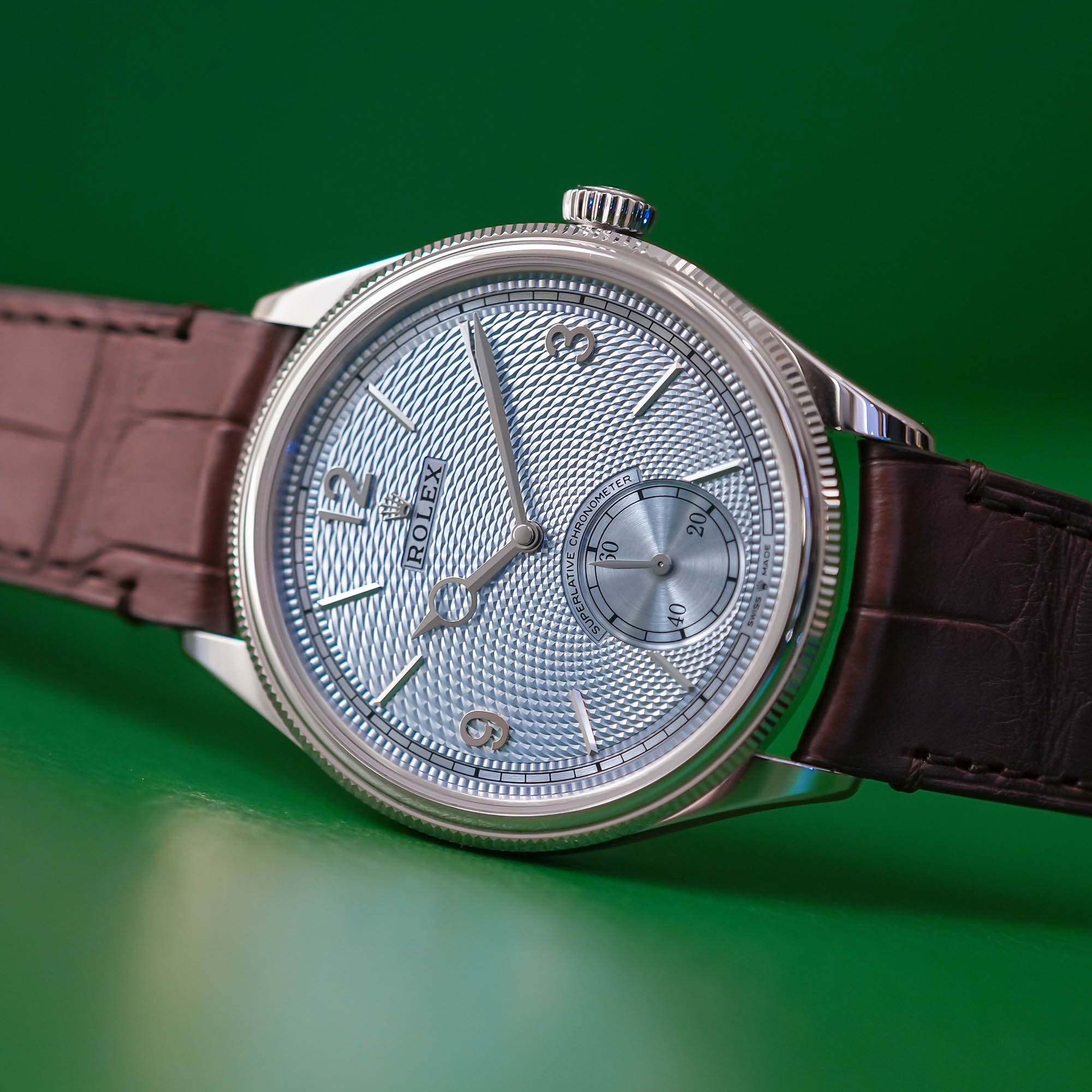




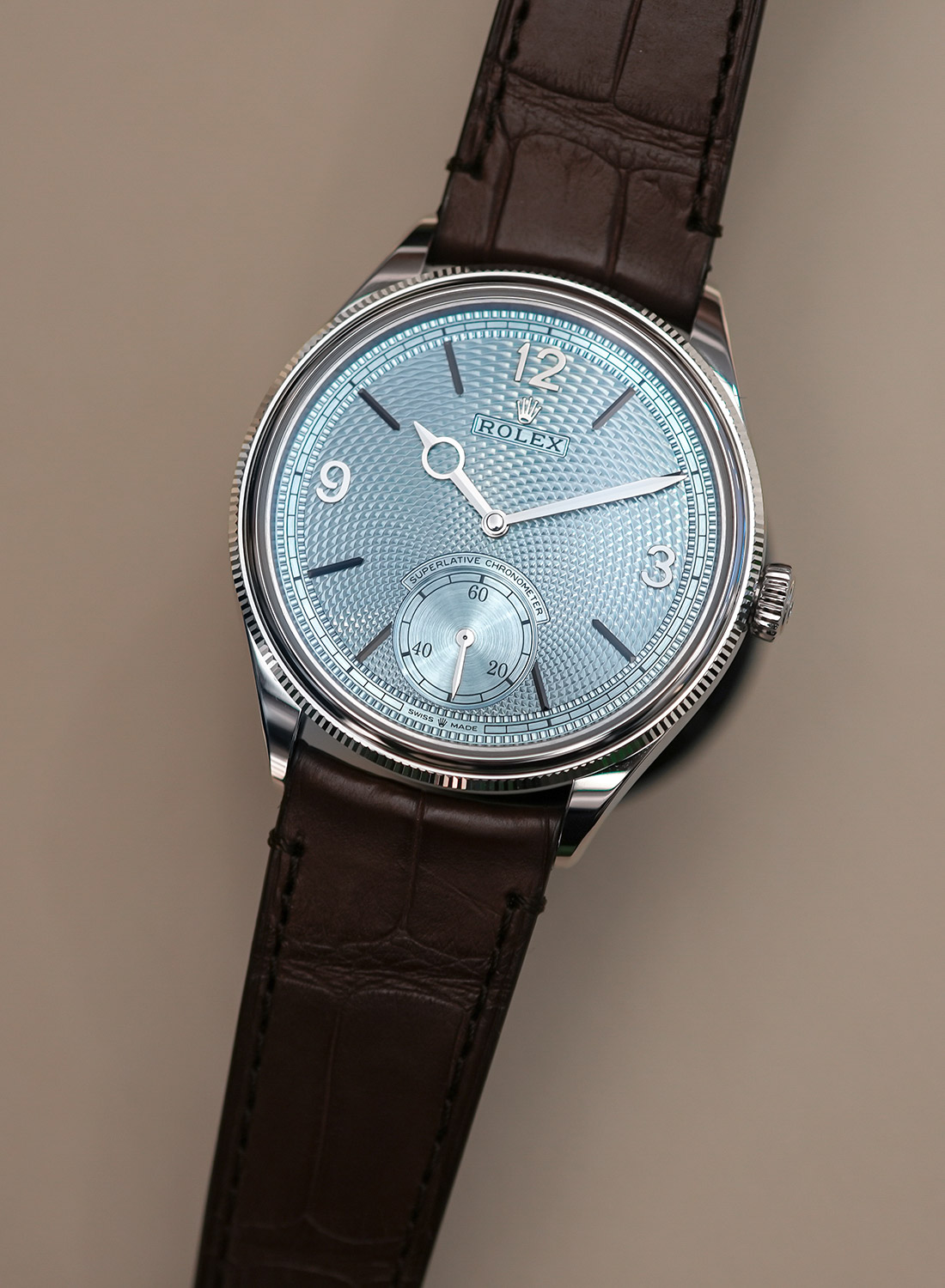





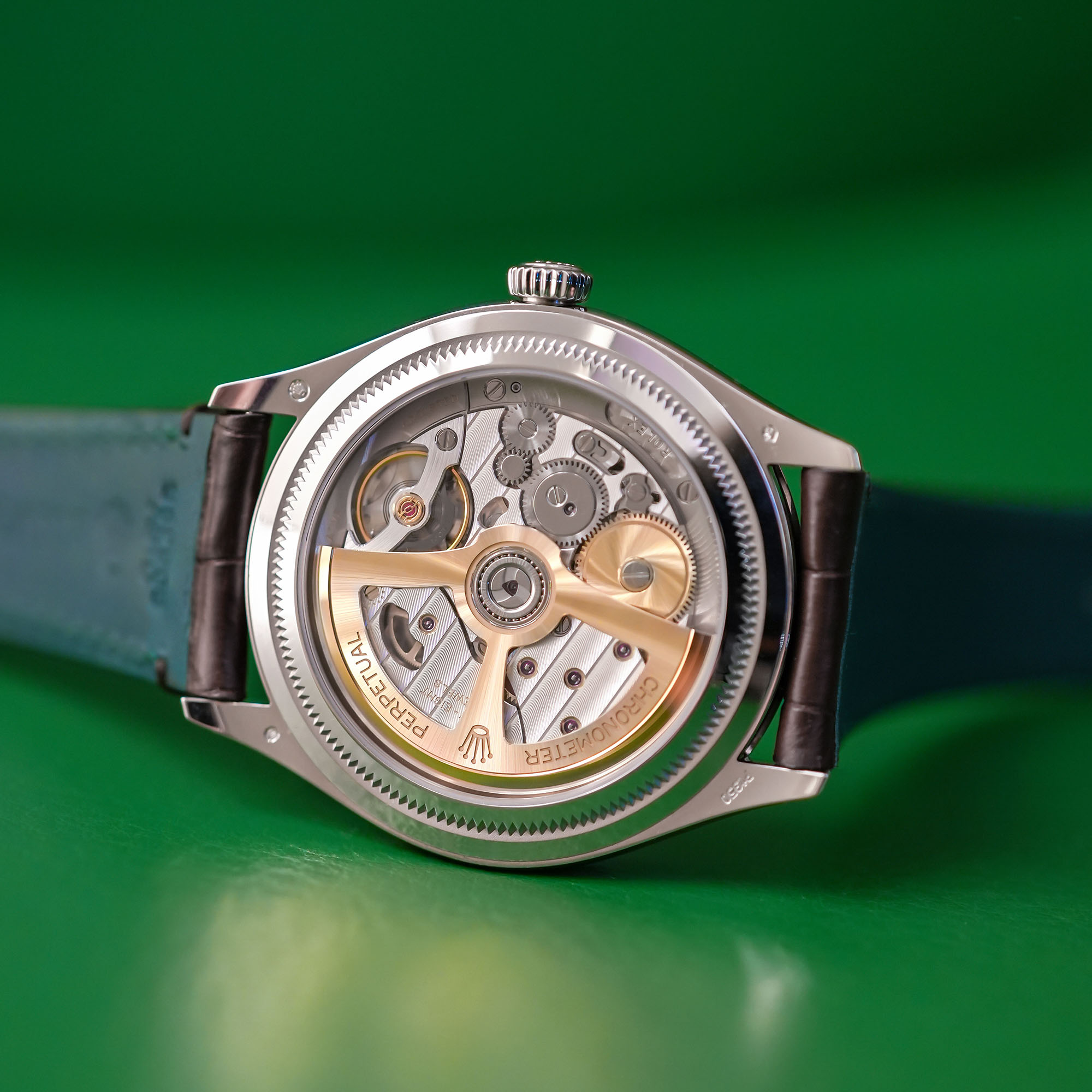
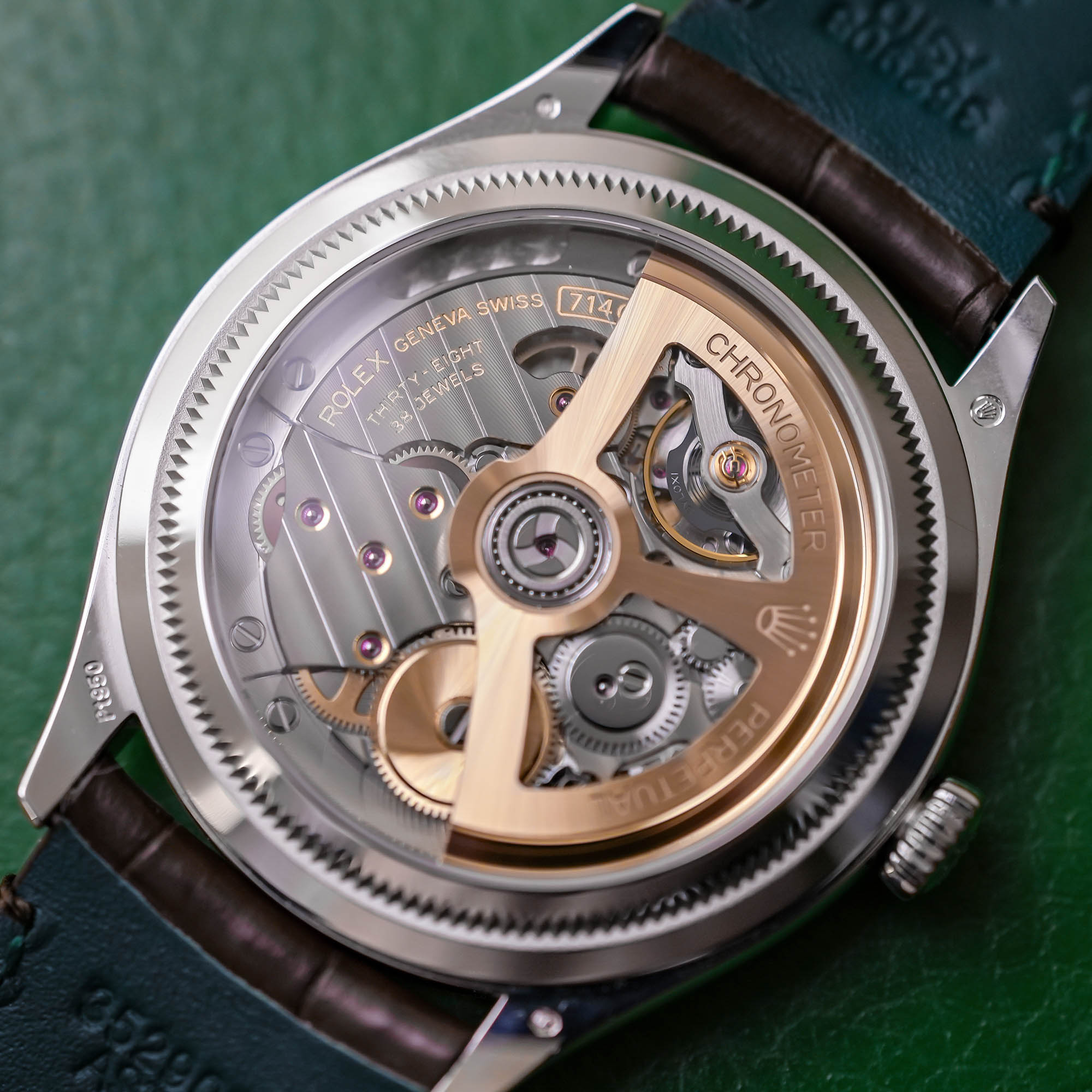
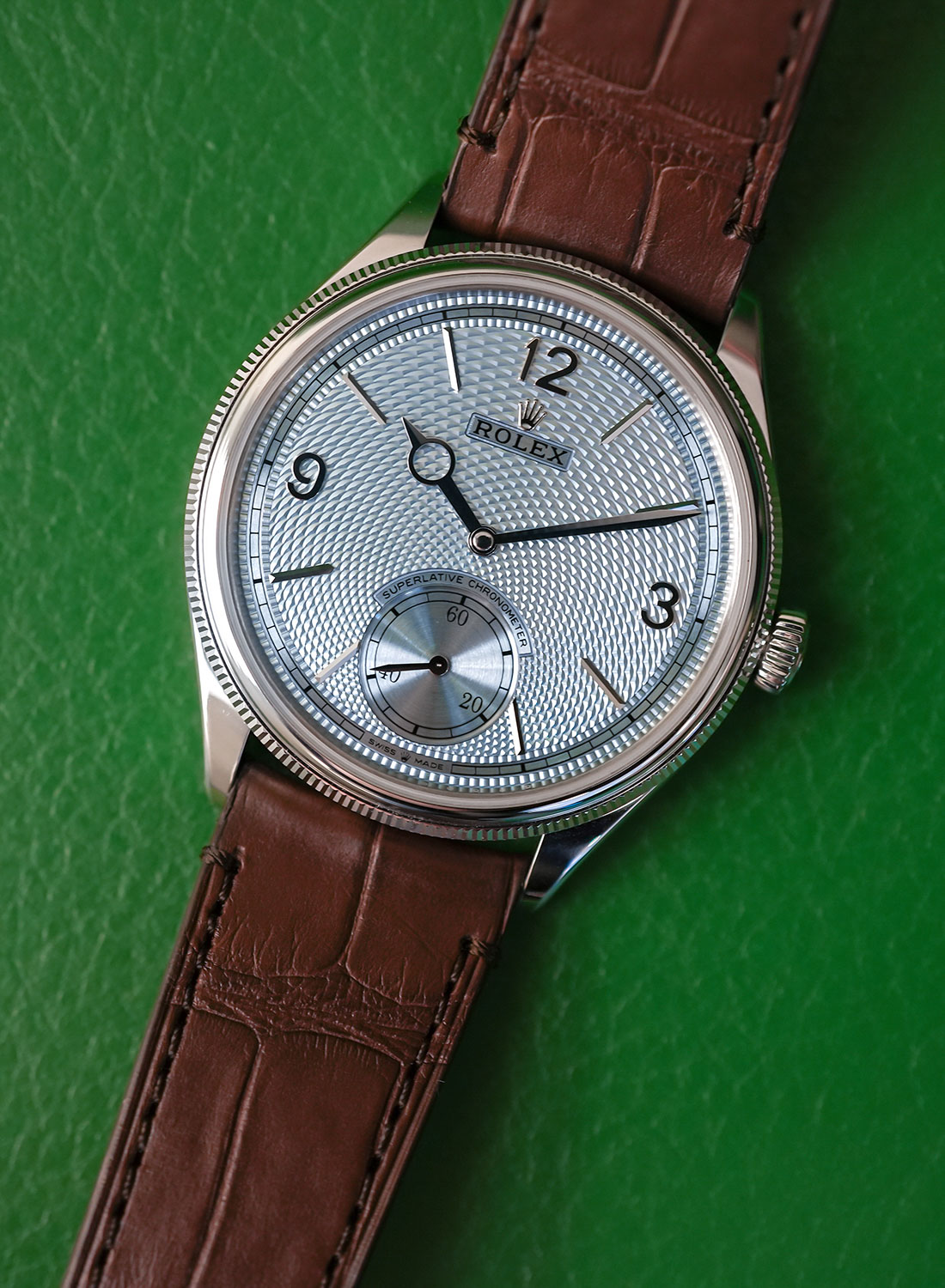
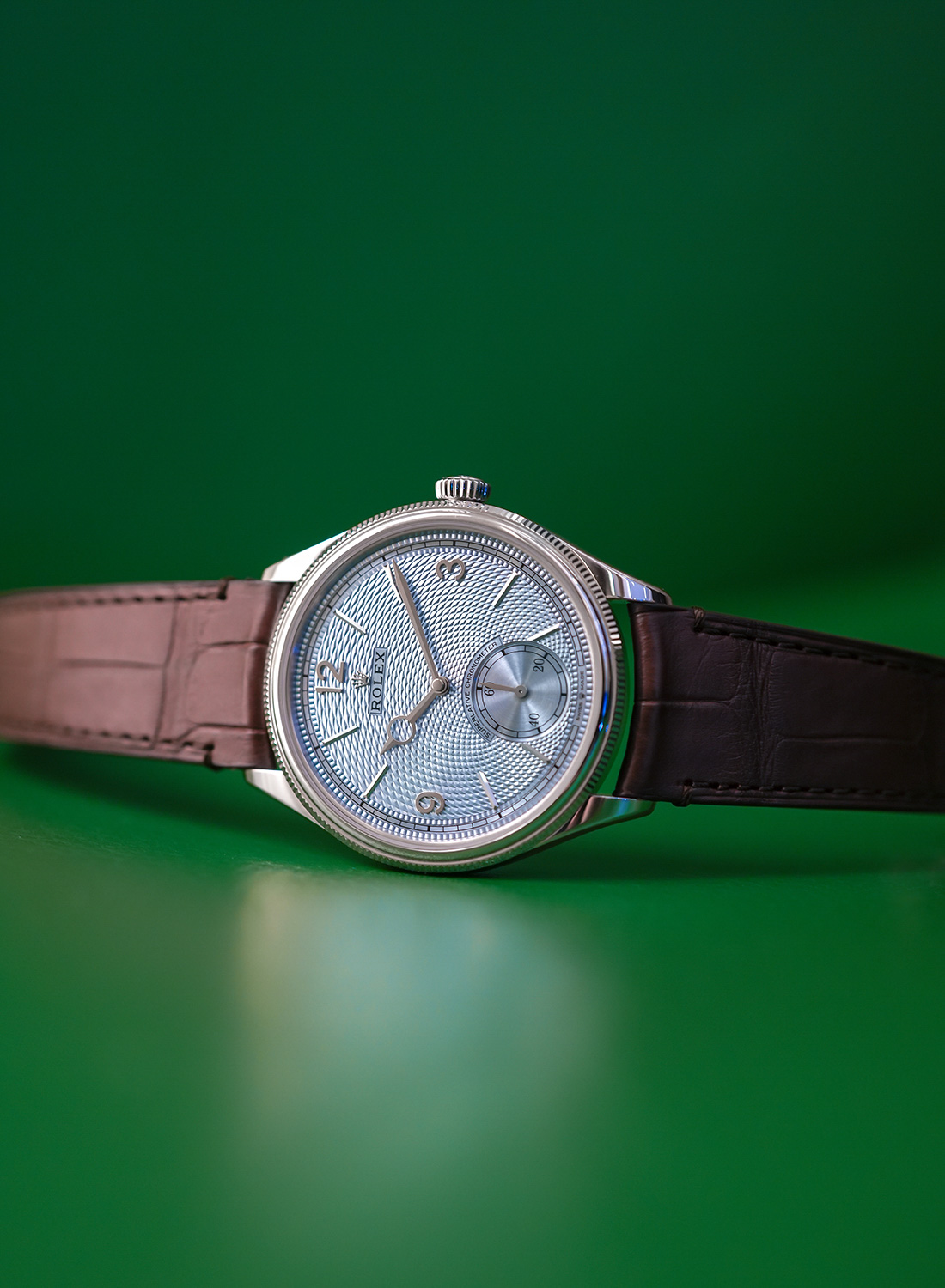




14 responses
From these pictures, I’m wondering what finishing there is on that movement.
No chamfers?
Are those engraved lines in between the striping to get rid of the difficult transition in the machining?
Are those gold chatons, or just gold colored recesses?
I’m not the biggest fan of dress watches, but for me, this is the best looking Rolex watch on sale right now
Oh, now I took the time to read the article, I found my answers. Quite disappointing.
They could easily tap into the skills at Carl F. Bucherer and start hand-finishing this movement.
Thanks for your quite informative article which, by the way, helped answer my question about the dial of this particular 1908 platinum edition posted in Xavier’s previous article.
Something NEW from Rolex a fancy dial and open back nice but 10 years to late and way overpriced.
@Hubertje – I was about to answer your first comment, saying that the details were actually in the article 🙂
So, on that topic, yes the movement is looking nice (better than most previous Rolex calibres), but certainly doesn’t have the manual touch of a VC or the latest PF Toric – the price isn’t the same either… There are thin diamond-cut chamfers in some places and indeed, the “gold chatons” are milled and gold toned (thus, these are not real chatons but a decoration). It’s a Rolex, thus a fine watch movement made according to industrial standards, not a haute horlogerie calibre. I however salute the effort for the dial and the fact that’s it’s been done in a far more traditional way. The question is more to know if we need Rolex to hand-decorate movements…? Not sure about that. Maybe that’s not where Rolex should be.
Rolex is a working man’s watch (which is exceptional in its own right). It cannot and should not be considered as a ‘dress option’.
I would rather knock on the doors of Lange and enjoy their fine movements.
The problem for the 1908, and for the Cellini line in general, which this watch is a mildly facelifted version of, is when Rolex attempt to enter the world of A. Lange und Sonne, Glashutte Original, Breguet, Patek, Vacheron, Audermars, JLC, Parmigiani, Piaget even Chopard LUC, the customer is reminded that this is not Rolex’s natural habitat. Rolex cannot compete on movement or dial or case finishing with any of the above brands. Rolex is a maker of reliable, robust high quality but mass-produced sports and tool-like watches. The great strentgh of the Rolex method, a single case design that is upsized or downsized as required by the watch coupled with standardised movements and very well designed and excuted bracelets works in a very narrow range of products. Looking at the Rolex cataqlogue, that is what Rolex has, a limited range of watches, for example the Submariner in steel has a black dial. There are no pink, blue, green, turquoise, yellow or orange dial Submariners. If you want one in steel it has a black dial with or without a date and if you want the date complication you can get a black or green bezel. It limits choice and makes the buying decision easy. The trouble is brands on a similar level to Rolex that have extensive varied catalogues like IWC and Omega tend to do “dress” watches better than Rolex because they still invest in the cases, designs and have a diverse design language that works better for “dress” watches. The Omega Consellation is not trying to mimic elements of the Speedmaster and the IWC Portofino is not trying to be a Big Pilot. Here though in a desparate attempt to retain Rolex elements there is a fluted bezel that looks incongruous, the hand set is too thick and inelegant for the size and style of the watch. The use of a very basically decorated movement is the final nail in the coffin for the 1908. The Sedna Gold Omega Tresor, which is a near competitor, has a better finished movement, it is by no means even close to a Glashutte Original or a JLC let alone VC, PP or AP, but it is far better than the Rolex. The IWC Portofino is possibly even better than the Omega although the movement is technically not a patch on the Omega. Rolex need to invest in new, better finished movements and get away from trying to make every watch look like a Datejust. But, that would then dilute the brand methodology.
@Brice Goulard
I’m not fully up to date with cureent pricing, but I would argue that this competes quite directly with the basic offers of some pretty prestigious classic (and by extension, less classic) brands like LUC, Lange, VC, Breguet, Moser, Czapek, not even speaking about Dornblueth, and co, where you get ánd the nice dial and handset, and case quality, ánd more (spectacular) decoration on the movements.
If the dial is traditionally made on a guilloche machine, I wonder how many machines they have and, more importantly, how many employees are skilled at it. I know that one employee can produce about 5 – 7 of these dials per day. So it’s unthinkable for Rolex if they want to sell thousands of watches of this model. It must be a joke that they do it themselves. These guilloché machines are almost impossible to find in usable condition. So someone will probably cut them for Rolex. If they are really made in the traditional way. Believe it or not. 😄
@reetzli – believe it or not… but I do believe it. Rolex doesn’t claim that the dial is done internally and it is very likely that they are working with a specialized company on that.
The Cellinis were very persuasive, and it is interesting Rolex wants to go high-end.
I like that Rolex wants to do more than signal arriviste tendencies.
Much as there’s a “Submariner and everything else is a copy” vibe to dive watches, this is a Breguet 7147 homage. It is still too thick and the hands are off.
FPJ has done well to re-interpret that house’s style. May Rolex do the same.
@ Talleyrand
Wholeheartedly agree about Journe’s successful re-interpretation of the Breguet style (I think of him as the 21st century’s true inheritor of Breguet’s baton, where Daniels was the 20th century’s), but I wouldn’t say Rolex are strictly attempting it here.
Admittedly the hour hand has something of the Pomme to it, but it’s so oversized as to be more like a ringpull, and very fine Clous de Paris is the hallmark of the Parisian style Breguet popularized and Roth re-introduced, not this more elaborate pattern.
I’d say what Rolex are doing here is more like a budget version of a Gronefeld Principia with Comblemine dial (even down to the arc of text over the subdial). Yes there’s a debt to what Breguet did, but I don’t interpret it as an attempt to observe that style.
What it is, I think is OK. Not pretty like a Breguet or Journe, but decent enough as a type of platinum watch with hand-guilloche dial – possibly by Metalem as Rolex has worked with them in the past – that you’d have to pay a lot more for with a name on the dial more closely associated with this style (Gronefeld, Voutilainen). Of course the movement is rough AF compared to theirs so it’s not that much of a bargain. ¦D